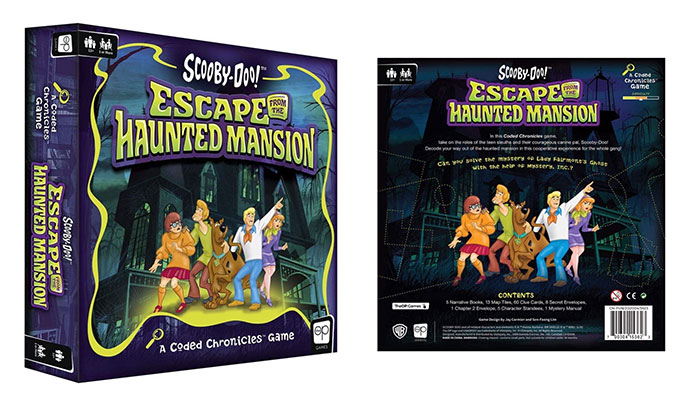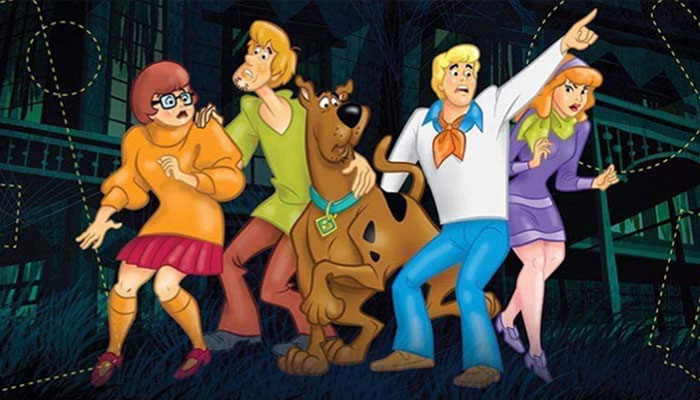—-
To stay in the loop with the latest features, news and interviews from the creative community around licensing, sign up to our weekly newsletter here

Sen-Foong Lim and Jay Cormier – creators of Junk Art, Akrotiri and more – on Scooby-Doo: Escape from the Haunted Mansion.
Fellas, you’ve worked on all kinds of games: party, deduction, dexterity, dice-rolling… One of your latest is a Coded Chronicles game; Scooby-Doo: Escape from the Haunted Mansion. What’s the idea?
Sen: Scooby-Doo: Escape from the Haunted Mansion is the first of a series of games called the Coded Chronicles Series. Both Jay and I love point-and-click adventure games such as those designed by Roberta Williams and Tim Schafer. We wanted to emulate the idea of exploration and puzzle solving along with narrative aspects that really immerse players in the characters they’re playing as.
Jay: What really separates this game from other escape-room-in-a-box games is just how strong the narrative is. The game comes with five narrative guides, one for each of the members of Mystery, Inc. As you use each character to interact with objects and people, you get to read what that character says. It’s like playing in an actual episode of Scooby-Doo! Players reportedly love to impersonate the characters’ voices!

Ha! I can imagine! So, it’s a cooperative escape game where each player gets to be Shaggy, Daphne, Fred, Velma or Scooby. In terms of the clue solving, though, how do you make sure they’re hard enough to intrigue but easy enough to get?
Jay: This is the fine line any puzzle designer has to walk. Every puzzle is easier when you, as the designers, know how it works. You need to recognise that making something slightly harder for you may, in fact, make it frustrating if not impossible for others. We don’t think that the challenge level should be reduced, but frustration should be.
Well, that sounds hard! How do you ensure you’re walking that line?
Sen: We don’t purposely build “red herrings” into any puzzles, for example – the players are really good at finding patterns where there aren’t any all on their own! So we test our puzzles as much as possible. The problem here is that once a person’s solved a puzzle, they can’t really be used to test it again. What has been seen cannot be unseen…

Jay: We learned early on in our playtesting that while Puzzle A might be quite easy when you only have the three elements of the puzzle pertaining to that puzzle in front of you, it gets more challenging when they get mixed in with other elements in the game from Puzzles B, C, and D.
I see; yes – it’s easier if I know the answer is definitely within those parameters…
Jay: Exactly. But it’s a lot harder if you’re not sure which clues you need to solve which puzzle! That meant that we had to do a lot of gating… We purposefully locked off areas of the mansion until certain puzzles were solved. We didn’t want the complexity of the game to escalate too quickly.
How did this idea come about? Did you approach The Op? Did The Op approach you?
Sen: The Op approached us with the idea of making escape-room-in-a-box games with the twist of having them in licensed worlds. The Op has long known about our mutual adoration of most things Scooby-Doo – sorry, Scrappy! So when they dreamed up the product, they knew who they could call on to make it a reality!

Did you have to qualify yourselves at all, though?
Jay: Yes; we had to pitch an idea of how we would do it. We knew right off the bat that if players were purchasing an escape-room game based on a license, they’d want to play AS the iconic characters from that world. You play as yourself in most escape room games – as if you are trapped in this place – but we wanted to involve the Mystery, Inc. characters throughout the adventure. We came up with the idea of Narrative Guides. In these, each character has a unique action word describing how they interact in a different way with objects in the game. The Op loved the pitch – and we’re currently developing the fourth game in the series!
Brilliant. Now, you’ve told us in a previous interview that you love the constraints of a brand-licensed title! How did they help on this occasion?
Sen: Scooby-Doo is such a time-honoured show, full of campy tropes and formulaic writing…
Careful; so are my interviews!
Sen: Well, I say these as almost-universally good things! In the case of Scooby-Doo, we were able to leverage a lot of standard story lines to ensure players who were familiar with any incarnation of the dog detective and his pals would feel like they were part of an episode of the show. For example, “Danger-Prone Daphne” is a trope in that she always gets into trouble on the show. In our game, we kept that trope while avoiding the all-too-common “Damsel-in-Distress” trope – our Daphne can take care of herself!

Jay: As we were trying to determine the action word that was going to be used for each character, we struggled a bit with Shaggy. Even watching years of the show, it was difficult to peg down what Shaggy does, exactly! We decided that Shaggy would “eat” as his action and leveraged that for humour throughout the game. We’ve since had players report back to us that they loved trying to eat anything and everything in the game – please try! However, we had to come up with at least two puzzles that required Shaggy’s unique action. He couldn’t just be for laughs, could he? That was tricky!
Well, to this point, the game does feel incredibly authentic. It really is like being inside one of the cartoons! How did achieve that? And how did you know when you had the right story, the right angle and the right game?
Sen: I personally have seen every episode of every cartoon that is even remotely Scooby-Doo related… From the original series and Mystery Inc. – the best – to the animated movies. I’ve also seen all the live-action movies and read the comics, including the very cool Scooby-Doo Apocalypse series from a few years back… So I’m a Doo-er, tried and true. I don’t know if that’s the term for Scooby fans, but – here and now – I’m stating my allegiance to all things Scooby… Except Scrappy!

I hear that. A little bit of Scrappy goes a long, long way…
Sen: We also read all the parts aloud with the character’s voices as we wrote them. This ensures that the passages flow well and that they’re aligned with what the character would say in that specific situation. We knew we had everything right when a lawyer from Warner-Brothers asked us which episode the game was based on after they had read the whole story. They thought that we just translated an existing show into a game! That was a real confidence booster, to be honest. It was really validating!
Jay: We wanted to have a few specific things in the game that are in a lot of the shows. As we were scripting our own mystery, we had to introduce the players to all of the characters residing in the mansion. We also had to leave real clues in the game because, while many Scooby-Doo episodes could end with almost anyone being the villain, we knew gamers would want a mystery they could actually solve. Players need to pay attention to a lot of details throughout the whole game to solve it, though! This culminates in the scene that everyone expects – the classic unmasking of the villain. It was a blast writing this segment!

I bet! I think that’s the best-loved trope of the lot, isn’t it? And let me ask, then… From your first conversations about the game to the final version, what was the biggest change?
Sen: We had hoped that one of the special features of this series would be a collectible that you had to construct by playing the game. It would provide hints or be part of the puzzle, but – at the end – you’d get this collectible that signified you’d escaped the Haunted Mansion… It was going to be a 3D Mystery Machine!
Jay: We also had to rewrite a significant amount of the narrative to balance each character’s time in the spotlight. Our first attempt relied heavily on Velma and kept Fred hidden until the end. Based on feedback from The Op, we knew this needed to change so we found a way to swap out Velma for Fred midway through the game. In the end, this change actually helped to make the game feel even more like an episode of Scooby-Doo!
What was the most interesting thing you learnt about Scooby-Doo while working on the Coded Chronicles title?
Sen: Even with as much as I’ve seen, Scooby-Doo has been around for 50 years and my brain can hold only so much! We learned a lot about all of the characters. Did you know that Velma was inspired by Zelda Gilroy from The Many Loves of Dobie Gillis? Well, you do now!
Jay: ABOUT Scooby-Doo? I learned which Pantone colour his tongue MUST be! I thought that was a funny, but understandably important, thing!
—
To read the full interview on our sister site Mojo Nation click here
Enter your details to receive Brands Untapped updates & news.